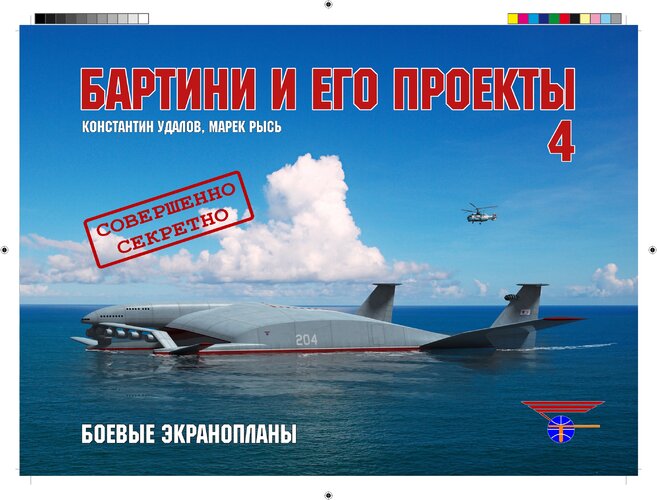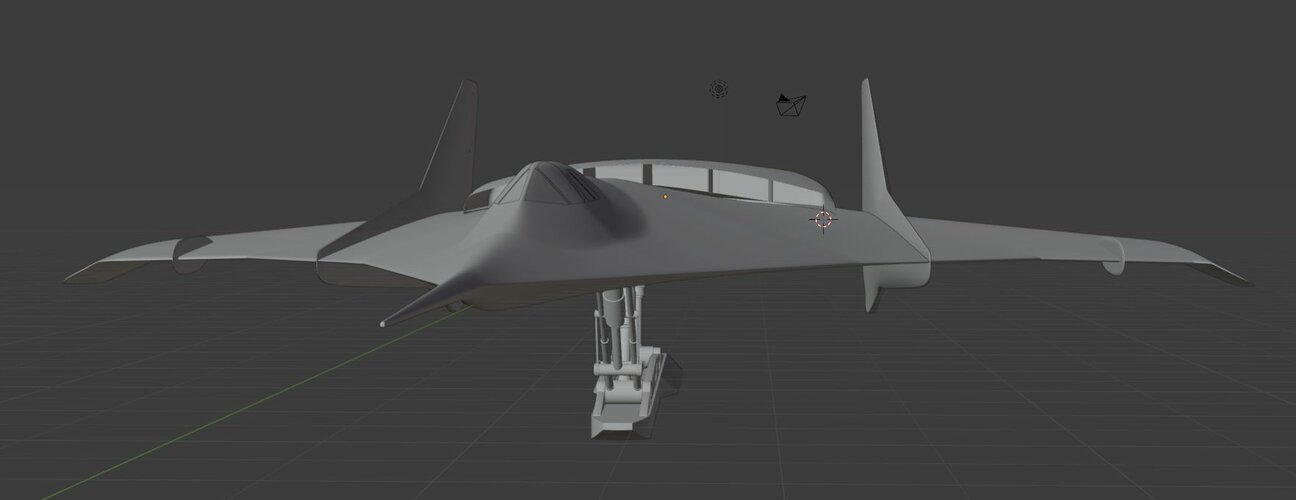athpilot
Fly me to the moon...
- Joined
- 18 November 2012
- Messages
- 396
- Reaction score
- 384
Удалов К. Г., Рысь Марек
Бартини и его проекты. Том 4. Боевые экранопланы.
- Москва. 2021 г., 176 с.
ISBN: 978-5-4465-3169-1
Hi! I had the opportunity to read Konstantin Udalovs latest book of his publication series about Bartinis work and designs (this is Vol. 4). This time he covers the widely unknown military/combat ekranoplans. This is truly amazing stuff, which was mostly never published before! Here Udalov cooparates with Marek Rys again (and Jozef Gatial), so the perfect combination between Text, Information and Artwork is guaranteed. The last years of his life R.L. Bartini actively promoted the idea of vertically taking off amphibians (MVA62, VVA 14, VVA 80, etc.), as well as combat ekranoplanes of gigantic dimensions: T 500 in two versions, A 2000 in five versions and A 2500. These are this book is all about.
This book covers the following items: Two introductions, one by the author and one by the senior "Honorary Aircraft Builder" A.A. Pukhov (p. 4). This is followed by the intruding chapter called "on the joined of the elements". Here the design program and further background is described (pp. 5-11). Here we find interesting information about the contexts, more informations about the build ekranoplans (KM-1, Lun, Orlyenok) and the interaction with the west in the Cold War. One foto of the KM-1 shown, with an additional pair of jet engines above and behind the cockpit section (which was new to me). Then comes the "combat ekranoplans": first in line is the „screener“ Ekranoplan ["ekranolyet"] T-500. This is one of the smaller project desbribed, but what a beast it was! It was designed in 1974 and would have a length of 115m and a wingspan of 72m. The empty weight was 500tons. To me the most interesting designs are ekranoplan aircraft and helicopter carriers. What innovative designs they were. Here we have the A-2000 (pp. 24-89). It was also designed in 1974 and its mass was about 1000 tons. The A-2000-1 variant was 35m high and had a wingspan of 129m. Variant A-2000-2 was similar but had two more engines (10 in total). The variant A-2000-4 was meant to carry the MiG-23. Take-off and landing there must have bee a true adventure. On page 66 is an original drawing showing the storage and launching mechanism. The A-2000-5 could carry up to 8 MiGs in ist belly on a revolving mechanism. Other defensive and combat weapons (e.g. rocket launcher) are described in detail. Also the fuel and other systems are described by original documents. Other (sea-)planes, such as the T-58M (a Su-15 variant) or the P-42 "Harpoon", were also considered for use onboard. Other variants of the A-2000 design-family were propsed as highspeed landing vessels. They couls carry up to ten medium tanks and disembark them through side hatches. The fighting tactics against US carrier groups by these russian flying carriers are described too (pp. 74-82). A truly big fat giant was the ekranoplan carrier A-2500 design (pp. 90-117). It would have been 183m in total length and had up to three decks for the carrier-aircrafts. Probably it should carry the Su-27K or Su-33. Then comes the dual-use highspeed twin-helicopter OS-70, the "ocean rescueer". Marek Rys already showed one of this artworks here on SPF. It could be used for military or civil uses in a wide range. Text, original documents and artworks are really fantastic here. OS-70 was also designed in 1974 - a very productive year for the Bartini designs team indeed - and would have been up to 300 Km/h fast. Another "ocean rescueer" dual-use was the spasatyel ekranoplan (pp. 132-143) There were plans for a worldwide network for these rescue vehicles. It carried at least one Kamov-Helicopter in the belly and other rescue equipment. It was also intended to help submarines which may have catch fire far away from the homebase. One render shows a spasatyel ekranoplan nearby a Typhoon-class sub which is on fire (p. 133). A huge water fire-extinction system comes through on of the ekranoplan fins, a helicopter is rescuing the crew. Then comes another ekranoplan screener, the T-200 series (T-220-1 an T-200-2). It was a fast WIG with a huge antenna array on its back (pp. 144-157) in diffrent arragements. Another interesting dual-use ekranoplane was the YeKho-50 (pp. 158-168) It was a very river ferry or could be used as a military transporter.
We had some of these projects here on the forum and wondered, if they were real or fake and why the soviets would need such big WIGs. Now we know!
The last 5 pages contain some nice teasers of the follow-up books: moree volumes on Bartini and on Myasishchev, such as theM-52 transporter giants will be next up. This will be fun (again)!
Cheers and enjoy your reading.
Бартини и его проекты. Том 4. Боевые экранопланы.
- Москва. 2021 г., 176 с.
ISBN: 978-5-4465-3169-1
Hi! I had the opportunity to read Konstantin Udalovs latest book of his publication series about Bartinis work and designs (this is Vol. 4). This time he covers the widely unknown military/combat ekranoplans. This is truly amazing stuff, which was mostly never published before! Here Udalov cooparates with Marek Rys again (and Jozef Gatial), so the perfect combination between Text, Information and Artwork is guaranteed. The last years of his life R.L. Bartini actively promoted the idea of vertically taking off amphibians (MVA62, VVA 14, VVA 80, etc.), as well as combat ekranoplanes of gigantic dimensions: T 500 in two versions, A 2000 in five versions and A 2500. These are this book is all about.
This book covers the following items: Two introductions, one by the author and one by the senior "Honorary Aircraft Builder" A.A. Pukhov (p. 4). This is followed by the intruding chapter called "on the joined of the elements". Here the design program and further background is described (pp. 5-11). Here we find interesting information about the contexts, more informations about the build ekranoplans (KM-1, Lun, Orlyenok) and the interaction with the west in the Cold War. One foto of the KM-1 shown, with an additional pair of jet engines above and behind the cockpit section (which was new to me). Then comes the "combat ekranoplans": first in line is the „screener“ Ekranoplan ["ekranolyet"] T-500. This is one of the smaller project desbribed, but what a beast it was! It was designed in 1974 and would have a length of 115m and a wingspan of 72m. The empty weight was 500tons. To me the most interesting designs are ekranoplan aircraft and helicopter carriers. What innovative designs they were. Here we have the A-2000 (pp. 24-89). It was also designed in 1974 and its mass was about 1000 tons. The A-2000-1 variant was 35m high and had a wingspan of 129m. Variant A-2000-2 was similar but had two more engines (10 in total). The variant A-2000-4 was meant to carry the MiG-23. Take-off and landing there must have bee a true adventure. On page 66 is an original drawing showing the storage and launching mechanism. The A-2000-5 could carry up to 8 MiGs in ist belly on a revolving mechanism. Other defensive and combat weapons (e.g. rocket launcher) are described in detail. Also the fuel and other systems are described by original documents. Other (sea-)planes, such as the T-58M (a Su-15 variant) or the P-42 "Harpoon", were also considered for use onboard. Other variants of the A-2000 design-family were propsed as highspeed landing vessels. They couls carry up to ten medium tanks and disembark them through side hatches. The fighting tactics against US carrier groups by these russian flying carriers are described too (pp. 74-82). A truly big fat giant was the ekranoplan carrier A-2500 design (pp. 90-117). It would have been 183m in total length and had up to three decks for the carrier-aircrafts. Probably it should carry the Su-27K or Su-33. Then comes the dual-use highspeed twin-helicopter OS-70, the "ocean rescueer". Marek Rys already showed one of this artworks here on SPF. It could be used for military or civil uses in a wide range. Text, original documents and artworks are really fantastic here. OS-70 was also designed in 1974 - a very productive year for the Bartini designs team indeed - and would have been up to 300 Km/h fast. Another "ocean rescueer" dual-use was the spasatyel ekranoplan (pp. 132-143) There were plans for a worldwide network for these rescue vehicles. It carried at least one Kamov-Helicopter in the belly and other rescue equipment. It was also intended to help submarines which may have catch fire far away from the homebase. One render shows a spasatyel ekranoplan nearby a Typhoon-class sub which is on fire (p. 133). A huge water fire-extinction system comes through on of the ekranoplan fins, a helicopter is rescuing the crew. Then comes another ekranoplan screener, the T-200 series (T-220-1 an T-200-2). It was a fast WIG with a huge antenna array on its back (pp. 144-157) in diffrent arragements. Another interesting dual-use ekranoplane was the YeKho-50 (pp. 158-168) It was a very river ferry or could be used as a military transporter.
We had some of these projects here on the forum and wondered, if they were real or fake and why the soviets would need such big WIGs. Now we know!
The last 5 pages contain some nice teasers of the follow-up books: moree volumes on Bartini and on Myasishchev, such as theM-52 transporter giants will be next up. This will be fun (again)!
Cheers and enjoy your reading.
Attachments
Last edited:


